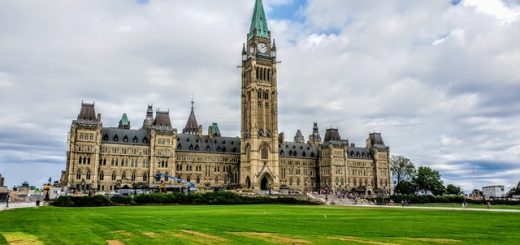What is the Matter? The Appeal Courts’ Error in Characterizing the Greenhouse Gas Pollution Pricing Act

The Ontario, Saskatchewan, and Alberta Courts of Appeal disagree about the application of the national concern branch of the federal peace, order, and good government (“POGG”) power. This disagreement can be resolved through a proper characterization of the purpose of the Greenhouse Gas Pollution Pricing Act, SC 2018, c 12, s 186 [GGPPA]. All three decisions fail to give adequate weight to the GGPPA’s long title and Preamble. Per its long title, the GGPPA is explicitly “[an] Act to mitigate climate change.” If the national concern doctrine feels like an awkward fit, it is only due to a failure by all three courts to properly characterize the GGPPA.
What is the GGPPA?
The GGPPA regulates 33 different greenhouse gasses (“GHG”) (Reference re Greenhouse Gas Pollution Pricing Act, 2020 ABCA 74, para 31 [ABCA Decision]). Part 1 of the GGPPA establishes a charge on various transport and heating fuels (ABCA Decision, para 33). Part 2 charges industrial producers for GHG output above certain prescribed limits, with different stringency for different industries (ABCA Decision, para 34). All revenues collected are distributed back to the province from which they originated (ABCA Decision, para 38). The GGPPA only applies to a province if its GHG pricing plan does not meet federal standards, which is why the GGPPA is often characterized as a “backstop” (ABCA Decision, para 35). The GGPPA’s Preamble recognizes that the failure of the provinces to enact stringent emissions regulations “could contribute to significant deleterious effects on the environment.” The federal government’s intention is clear: climate change is a collective problem, and every province and territory has a role to play in mitigating its effects.
Division of Powers Analysis – A Brief Primer
To determine whether a law falls under federal or provincial jurisdiction, the courts ask what the pith and substance of the law is and, based on that analysis, assign it to a head of power from section 91 or section 92 of the Constitution. The pith and substance is found by examining the stated purpose, legal effects, social and economic context (often using extrinsic evidence) and actual—not necessarily stated—purpose of the law (Reference re Firearms Act, 2000 SCC 31, paras 16–18 [Firearms Reference]).
Once a conclusion on the matter of the law is reached, the law must be classified under a head of power. The core issue is whether the GGPPA falls within the scope of the national concern branch of the federal peace, order, and good government power, making it a valid exercise of federal constitutional power. The national concern branch applies to new matters and to matters that have risen to the level of national importance (R v Crown Zellerbach Canada Ltd, [1988] 1 SCR 401 at para 33 [Zellerbach]). It does not apply to temporary national emergencies (Zellerbach, para 33). The matter must be single, distinctive, and indivisible, and thus clearly distinguished from a provincial head of power (Zellerbach, para 33). Finally, it must be an issue the provinces cannot regulate on their own (Zellerbach, para 33). If the law meets each of these four tests, then it falls within federal jurisdiction to regulate.
The Pith and Substance of the GGPPA
The characterization of a law is the most consequential step in a division of powers analysis. Broad, catch-all categories such as Property and Civil Rights or Trade and Commerce are key to our constitutional design, but they also cause frustrating flexibility. Often, a particular law could fit under several heads of power depending on how it is defined. Therefore, how the law is understood will have a great impact on the categorization analysis and, ultimately, its constitutionality.
To determine the purpose of a law, both intrinsic evidence, such as the Preamble, and extrinsic evidence, such as the circumstances in which the law was enacted, must be considered (Rogers Communications Inc. v. Châteauguay (City), 2016 SCC 23 at para 36). One should consider the “mischief” of the legislation—the problem Parliament sought to remedy (Firearms Reference, para 17). Both the legal and practical effects of the law are also considered (Firearms Reference, para 18). Each of these aspects must be given appropriate weight. All three Courts of Appeal place too much emphasis on the effects of the law and leave the purpose behind.
The ABCA acknowledges that the characterization of the law has been a troubling point: “[u]p to and including this Reference, counsel and courts have struggled to define the subject matter of the Act” (para 197). The Ontario Court of Appeal characterizes the law as “establishing minimum national standards to reduce greenhouse gas emissions” (Reference re Greenhouse Gas Pollution Pricing Act, 2019 ONCA 544 at para 77 [ONCA Decision]). The Saskatchewan Court of Appeal characterizes the law as the “establishment of minimum national standards of price stringency for GHG emissions” (Reference re Greenhouse Gas Pollution Pricing Act, 2019 SKCA 40 at para 125 [SKCA Decision]). Finally, the ABCA characterizes it as “regulation of GHG emissions” (ABCA Decision, para 256). The only point of consensus is that the law clearly deals with GHG emissions.
The GGPPA, far from being a targeted attack on any province’s authority over their natural resources, as Alberta contends, was plainly enacted to respond to the most pressing call of our generation: the fight against climate change. Through reference to the United Nations Framework Convention on Climate Change, the Paris Agreement, and Canada’s own internal targets and agreements, the GGPPA is an attempt to honor those commitments by turning them into mandatory, uniform action. The Preamble further recognizes the importance of collective action, calling out the harm that could result from one province’s failure and recognizing that climate change “cannot be contained within geographic boundaries.” Only Ontario’s characterization of the GGPPA gets close to appreciation of the Preamble by acknowledging that the GGPPA focuses on reducing GHGs, not just regulating them (ONCA Decision, para 77). The Preamble cannot be lost in the pith and substance analysis if courts want to accurately summarize the matter of the GGPPA.
Despite the differences in each court’s ultimate characterization of the GGPPA, there are striking similarities in their analysis. All three decisions look to the Preamble and conclude the GGPPA’s purpose is to tackle climate change. The SKCA states that “the Act is the product of Canada’s efforts to meet its commitments under the Paris Agreement” (SKCA Decision, para 119). The ONCA says “its effect is to put a price on carbon pollution, thereby limiting access to a scarce resource: the atmosphere’s capacity to absorb GHGs” (ONCA Decision, para 76). The ABCA is most explicit: “there can be no doubt that the purpose of the Act is to mitigate climate change” (ABCA Decision, para 219). All three judgments quickly forget these assertions as they move onto analyzing the legal and practical effects of the GGPPA. The effects should not be forgotten, but the characterization is not complete without asserting why it matters that we reduce GHG emissions. A cohesive analysis demands the purpose of the legislation not be forgotten.
A close examination of the Preamble gives all the needed clues to the purpose of the legislation. The Preamble begins by acknowledging the scientific consensus that GHGs emissions caused by human activity are warming our planet and the devastating effects on all Canadians. Agreements recognizing this reality and holding Canada to an obligation to change are highlighted. A conclusion that behaviour change towards a “increased energy efficiency, to the use of cleaner energy, [and] to the adoption of cleaner technologies” is needed. Finally, the pricing of GHG emissions is meant as a tool to trigger necessary behavioural change. Therefore, the GGPPA is clearly not regulating GHGs for the sake of doing so. The stakes of this law are set out as the prevention of catastrophic global warming and all the consequences that would entail for Canadians. A proper characterization of the law would center the role of the legislation in the fight against climate change. I propose the following: the GGPPA aims to establish minimum national GHG emission pricing standards to ensure collective action to mitigate the effects of catastrophic climate change.
I specifically use the term “catastrophic,” and urge the Supreme Court of Canada (“SCC”) to do so because that is exactly the scale of disaster we are facing. The Intergovernmental Panel on Climate Change’s 2018 report on the consequences of 1.5 degrees Celsius of warming lays bear the science, and the key takeaway is rapid GHG reduction is needed or else our lives will be in peril. In a recent ground-breaking climate change case, Urgenda Foundation v State of the Netherlands, [2015] HAZA C/09/00456689, the Dutch Supreme Court, drawing on global climate science, acknowledged the “real threat of dangerous climate change,” and found the State has a duty to protect its people against this threat (paras 44–45). The use of urgent language signals to legislators that the SCC takes climate science seriously. Recognizing the precarious state of our planet would not be an instance of judicial activism, it would simply be noting a scientific reality. I will next consider the effect of this characterization of the GGPPA on the national concern analysis.
The National Concern Doctrine
The most contentious part of the national concern analysis is determining whether the matter has “a singleness, distinctiveness and indivisibility that clearly distinguishes it from matters of provincial concern and a scale of impact on provincial jurisdiction that is reconcilable with the fundamental distribution of legislative power under the Constitution…it is relevant to consider what would be the effect on extra‑provincial interests of a provincial failure to deal effectively with the control or regulation of the intra‑provincial aspects of the matter” (Zellerbach, para 33). The proposed characterization of the GGPPA makes this part of the analysis simple, overcoming many of the concerns raised by the Alberta Court of Appeal.
Recognizing the fight against climate change as a key aspect of the legislation ensures the new federal head of power created by the national concern branch is narrowly focused rather than usurping a large area of provincial jurisdiction. Regulation of GHG emissions alone is a broad purpose that allows the federal government carte blanche to legislate on any aspect of those emissions. Constraining the power to the mitigation of climate change places a burden on the federal government to prove their legislation will have a measurable effect on combatting the crisis and thus a genuinely pressing reason for enactment. The provinces will not be subject to federal whims, as the ABCA fears, but will be subject to regulations intended to ensure the continued safety of all Canadians. This narrower characterization easily meets the test for singleness. It characterizes the law at the lowest level of abstraction by tying the effects of the law to the purpose, precisely stating its goal.
Distinctiveness requires that the matter be beyond the capacity of any one province to effectively manage (ONCA Decision, para 113). The ABCA contends that because any province can—and many already have—enacted their own carbon pricing schemes, this matter is clearly not beyond the constitutional capacity of the provinces (ABCA Decision, para 291). However, the ABCA only reaches this conclusion by overlooking half of the matter of the law—its purpose of climate change mitigation. A province can regulate GHG emissions, but a province cannot set minimum standards that coordinate meaningful national climate action. As the Preamble recognizes, climate change is an issue that knows no borders. The failure of one province to regulate its emissions puts all others in jeopardy. Only the federal government can ensure collective action commensurate with the severity of the climate crisis. The fulfillment of Canada’s promises under the Paris Agreement—and human survival more broadly—depend on it.
Indivisibility requires that the matter not be an aggregate of provincial competences but have its own integrity (ONCA Decision, para 113). Alberta contends that the matter is an aggregate of provincial powers (ABCA Decision, para 288). The ABCA leaves out the purpose, fitting the law under the provincial power to regulate Property and Civil Rights. It is the error of failing to give weight to their earlier finding that the law’s purpose is to combat climate change that led the ABCA to a classification that, though appropriate for their characterization, is not appropriate for the GGPPA. The creation of a uniform plan of attack on GHG emissions across the country is a matter with its own integrity fully beyond provincial power.
Alberta further contends that the source of emissions is readily identifiable and thus the matter is not indivisible (ABCA Decision, para 293). The issue, when the law is properly characterized as relating to the fight against climate change, is clearly not with the source of emissions but with the locations of their effects. Science cannot pinpoint which emissions caused which disaster, only that the contribution to the whole of global emissions is causing climate disasters all over the globe. This is also an issue that more properly falls under the distinctiveness analysis as it relates to the inability of any one province to manage the matter.
The ABCA does not find that the minimum standards approach adopted by the legislation places it firmly within federal jurisdiction. The majority writes that “there is no separate head of federal power relating to minimum national standards of anything. Nor is backstoppism a separate head of federal power” (ABCA Decision, para 294). The ABCA is correct that this does not constitute a separate head of power. The question of this trilogy of cases is whether, more narrowly framed, it ought to. The Constitution is a living tree, which should be given a “large and liberal interpretation” and is meant to evolve with the changes of each era (Edwards v AG of Canada, [1930] AC 124 at pages 106–107). Climate change is the defining challenge of the century and the division of powers analysis is flexible enough to adapt to these extreme circumstances. Quite literally, climate change is of national concern; as a nation, the potential loss of land and livelihood due to increasingly frequent fire, flood and other natural disasters is deeply concerning. Per the doctrine of national concern, emissions regulation to mitigate climate change is a legitimate exercise of the federal POGG power.
Bringing climate change to the forefront makes it clear that the matter contemplated meets the criteria of singleness, distinctiveness and indivisibility required to establish a new head of power under the national concern branch of the POGG power. Even more importantly, it makes clear the urgency of doing so; our Constitution can and must evolve to meet the modern challenge of climate change. The GGPPA is crucial to accomplishing together what each province, acting alone, cannot.
The Impact on Provincial Jurisdiction and the Issue of Exclusive Federal Jurisdiction
The SCC should revise the national concern branch to better equip it to meet the challenges of the present era by clarifying that exclusive federal jurisdiction granted under the national concern branch does not preclude provincial legislation that meets or exceeds the standards set out by the federal government. The proposed characterization already makes it clear that the federal government can establish minimum, not maximum, standards for the regulation of GHG emissions, but this step would provide additional comfort to nervous provinces. The national concern branch should be read through the lens of the principles of cooperative federalism—a matter of national concern is exactly the type where provincial and federal governments should work together. Provincial inability to act alone on the issue does not mean the federal government would not benefit from provincial assistance on the matter.
The SCC should also follow the guidance in Multiple Access Ltd v McCutcheon: “there would seem to be no good reasons to speak of paramountcy and preclusion except where there is actual conflict in operation as where one enactment says ‘yes’ and the other says ‘no’ ([1982] 2 SCR 161 at para 191 [Multiple Access]). If the federal legislation sets the minimum standard, a provincial law setting an equal or stronger standard should not be read as conflicting unless compliance with one is defiance of the other. Rather, the SCC should make it clear the establishment of this new federal head of power does not preclude provincial own legislation in this domain so long as it does not directly contradict the federal law.
The impact on provincial jurisdiction would accordingly be diminished if the national concern branch were restated with explicit mention of cooperative federalism and the guidance in Multiple Access. Such a minor revision would bring the national concern branch into the modern era of complex regulatory issues.
On Final Appeal
When the SCC contemplates these three appeals, it should give proper weight to the purpose driving the GGPPA—combatting climate change—and ensure that this purpose is carried through the division of powers analysis. The SCC should also use this opportunity to clarify that the exclusive jurisdiction carved under the national concern branch should be understood in light of the principle of cooperative federalism, not despite it. When a matter is of national concern, cooperation is more important than ever, and provincial regulation that augments, rather than conflicts, with the GGPPA should be encouraged. With these points in mind, the SCC will hopefully honour the purpose of the GGPPA and breathe life into our living tree Constitution, upholding legislation that works to ensure a liveable climate for future generations of Canadians.








Join the conversation